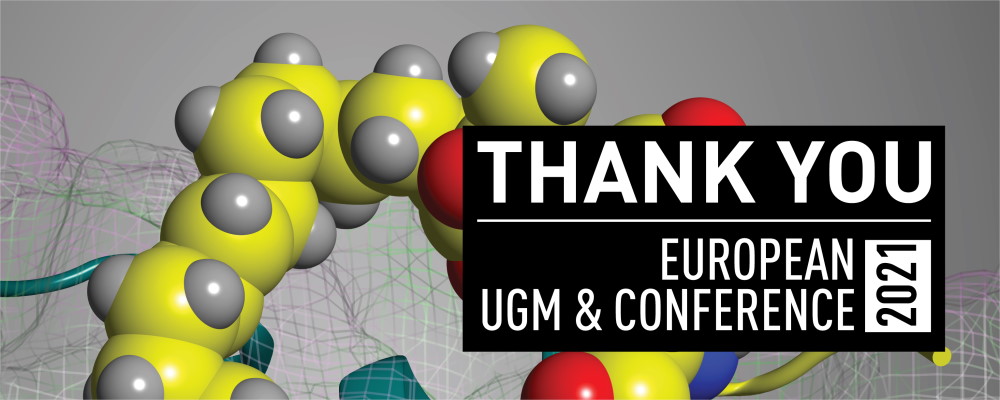CCG’s 2021 European UGM & Conference will take place online, on May 19-20. The annual UGM & Conference is a 2-day online event based in the Central European Time (CET) zone, consisting of morning workshops, a lunchtime poster session, and afternoon scientific presentations on diverse topics associated with computational chemistry and biology, drug discovery and design. The first day (May 19, 2021) focuses on applications in biological therapeutics, protein modelling and engineering, whereas the second (December 12, 2025) concentrates on small molecule drug discovery, medicinal chemistry and chemoinformatics applications.
Antibody Modeling and Protein Engineering
Protein Engineering / Protein Properties / Developability / Hot Spot Analysis / Antibody Modeling / Humanization / Molecular Surfaces
Andrew Henry, Senior Applications Scientist,Chemical Computing Group (UK)
Protein Engineering / Protein Properties / Developability / Hot Spot Analysis / Antibody Modeling / Humanization / Molecular Surfaces
Andrew Henry, Senior Applications Scientist,
Break | Free Time
Biologics: Protein Alignments, Modeling and Docking
Protein Alignments and Superposition / Loop and Linker Modeling / Homology Modeling / Protein- Protein Docking
Sarah Witzke, Applications Scientist,Chemical Computing Group (UK)
Protein Alignments and Superposition / Loop and Linker Modeling / Homology Modeling / Protein- Protein Docking
Sarah Witzke, Applications Scientist,
Posters & Group Discussions
Opening Remarks
Charting Therapeutically Relevant Protein Conformational Space with Adaptive MD
Silvia Lovera, Senior Scientist,UCB Biopharma SPL (BE)
Silvia Lovera, Senior Scientist,
Computational Evolution of Threonine-Rich β Hairpin Peptides Mimicking Specificity and Affinity of Antibodies
Morten Meldal, Professor in Chemistry,University of Copenhagen (DK)
Morten Meldal, Professor in Chemistry,
Developability Optimization of Antibodies
Anette Henriksen, Principal Scientist,Novo Nordisk A/S (DK)
Anette Henriksen, Principal Scientist,
Developability Assessment and Property Prediction by pH-Dependent Conformational Sampling
Andrew Henry, Principal Scientist,Chemical Computing Group (UK)
Andrew Henry, Principal Scientist,
Using MOE's "Ensemble Protein Properties" in Early Developability Assessment of Therapeutic Antibodies
Hubert Kettenberger, Senior Principal Scientist Protein Engineering,Roche Diagnostics GmbH (DE)
Hubert Kettenberger, Senior Principal Scientist Protein Engineering,
Analysis of TCR-pHLA Complex Crystal Structures in MOE Using a Custom SVL Script
Ross Robinson, Associate Director, Protein Engineering,Immunocore Ltd (UK)
Ross Robinson, Associate Director, Protein Engineering,
Platformization of Multi-Specific Protein Engineering: Leveraging High-Throughput Screening Data for in silico Antibody Design
Norbert Furtmann, Head of Data Lab, High Throughput Biologics,Sanofi Deutschland GmbH (DE)
Norbert Furtmann, Head of Data Lab, High Throughput Biologics,
Closing Remarks
Further Discussions | Social Interactions (Bring Your Own Beverage)
Small Molecule Virtual Screening
MOE Databases / Descriptors / Fingerprints / QSPR Modeling / Pharmacophore Modeling / Template-Forced Docking / Scaffold Replacement / MedChem Transformations
Barbara Sander, Senior Applications Scientist,Chemical Computing Group (DE)
MOE Databases / Descriptors / Fingerprints / QSPR Modeling / Pharmacophore Modeling / Template-Forced Docking / Scaffold Replacement / MedChem Transformations
Barbara Sander, Senior Applications Scientist,
Break | Free Time
Advanced Structure-Based Drug Design
Pharmacophore Modeling / Docking / Fragment-based Design / Scaffold Replacement / R-Group Screening / Project Search / Protein-Ligand Interaction Fingerprints
Freya (Klepsch) Trasischker, Senior Applications Scientist,Chemical Computing Group (AT)
Pharmacophore Modeling / Docking / Fragment-based Design / Scaffold Replacement / R-Group Screening / Project Search / Protein-Ligand Interaction Fingerprints
Freya (Klepsch) Trasischker, Senior Applications Scientist,
Posters & Group Discussions
Opening Remarks
Exploring FE Calculations in Drug Discovery Programs and Collaborations
Gary Tresadern, Senior Principal Scientist,Janssen R&D (ES)
Gary Tresadern, Senior Principal Scientist,
Understanding Molecule Conformation in Solution: Refining Conformational Analysis with NMR Data
Iuni Trist, Principal Scientist,Aptuit, an Evotec company (IT)
Iuni Trist, Principal Scientist,
Almost Square: The Impact of Oxetanes on Compound Design
Anders Johansson, Team Leader Chemistry,AstraZeneca (SE)
Anders Johansson, Team Leader Chemistry,
Modeling PROTAC-Mediated Targeted Protein Degradation: Case Studies and Recent Developments
Mike Drummond, Scientific Applications Manager,Chemical Computing Group (US)
Mike Drummond, Scientific Applications Manager,
Molecular Basis and Design of NADH Competitive Inhibitors: The Case of PYCR1
Rafael S. Depetris, Principal Scientist II – Head of Structure Based Drug Design,Kadmon (US)
Rafael S. Depetris, Principal Scientist II – Head of Structure Based Drug Design,
Preparing Shape-Diverse Relevant Conformer Sets Using Quantum Chemistry and Cheminformatics
Jimmy Kromann, Data Scientist,Novartis (CH)
Jimmy Kromann, Data Scientist,
Charting Medicinal Chemistry Design Space for Rapid Ideation
Mahendra Awale, Postdoctoral Research Fellow,F. Hoffman La Roche (CH)
Mahendra Awale, Postdoctoral Research Fellow,
Closing Remarks
Further Discussions | Social Interactions (Bring Your Own Beverage)


